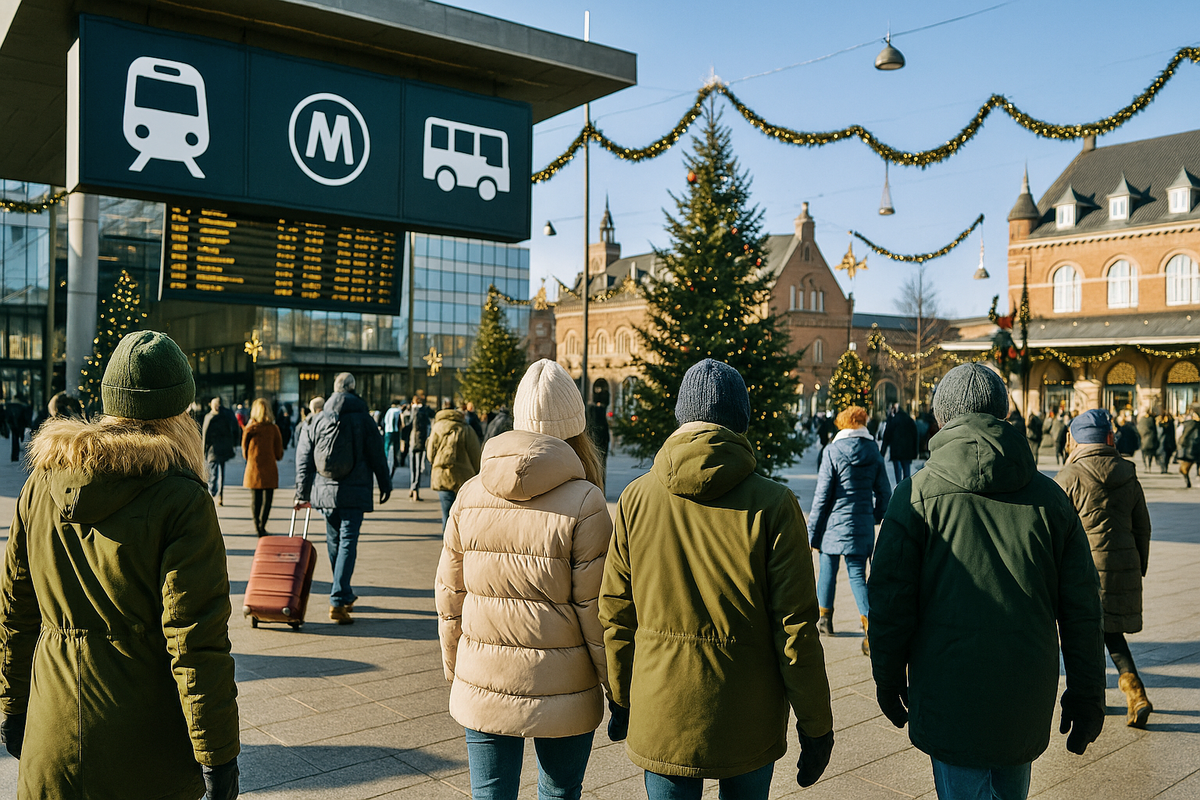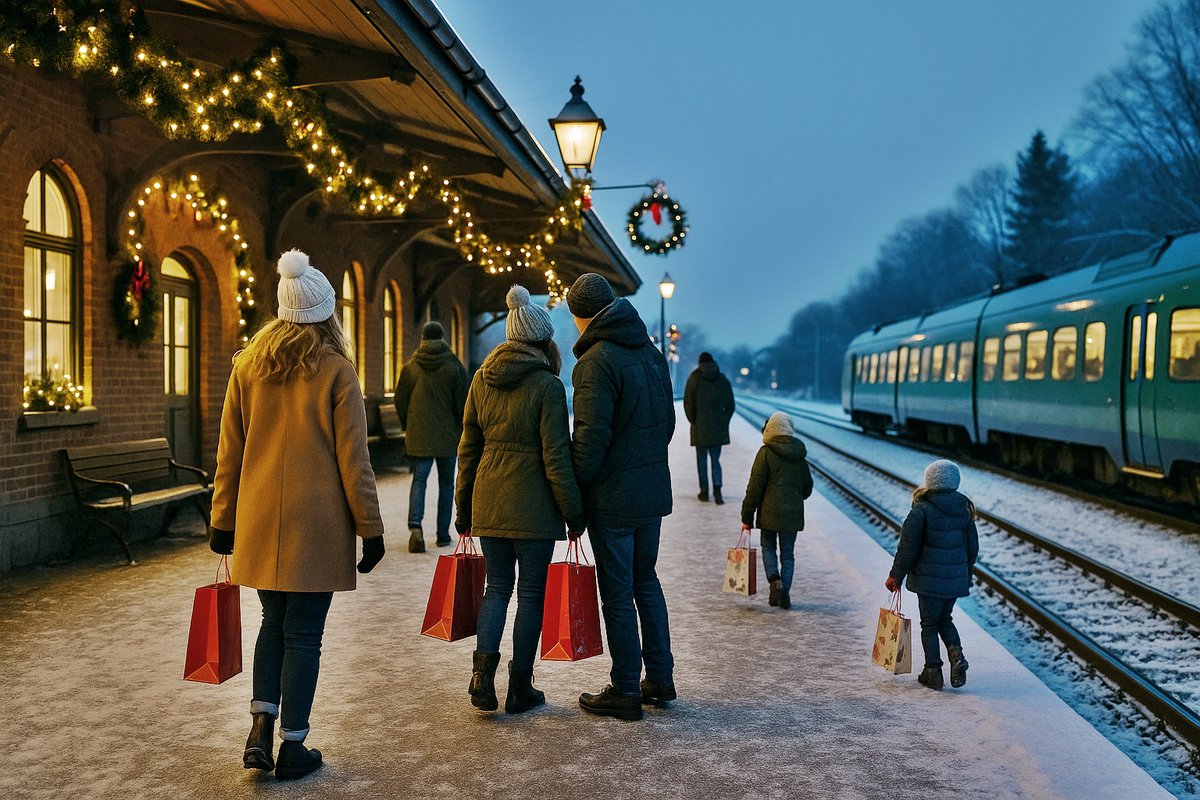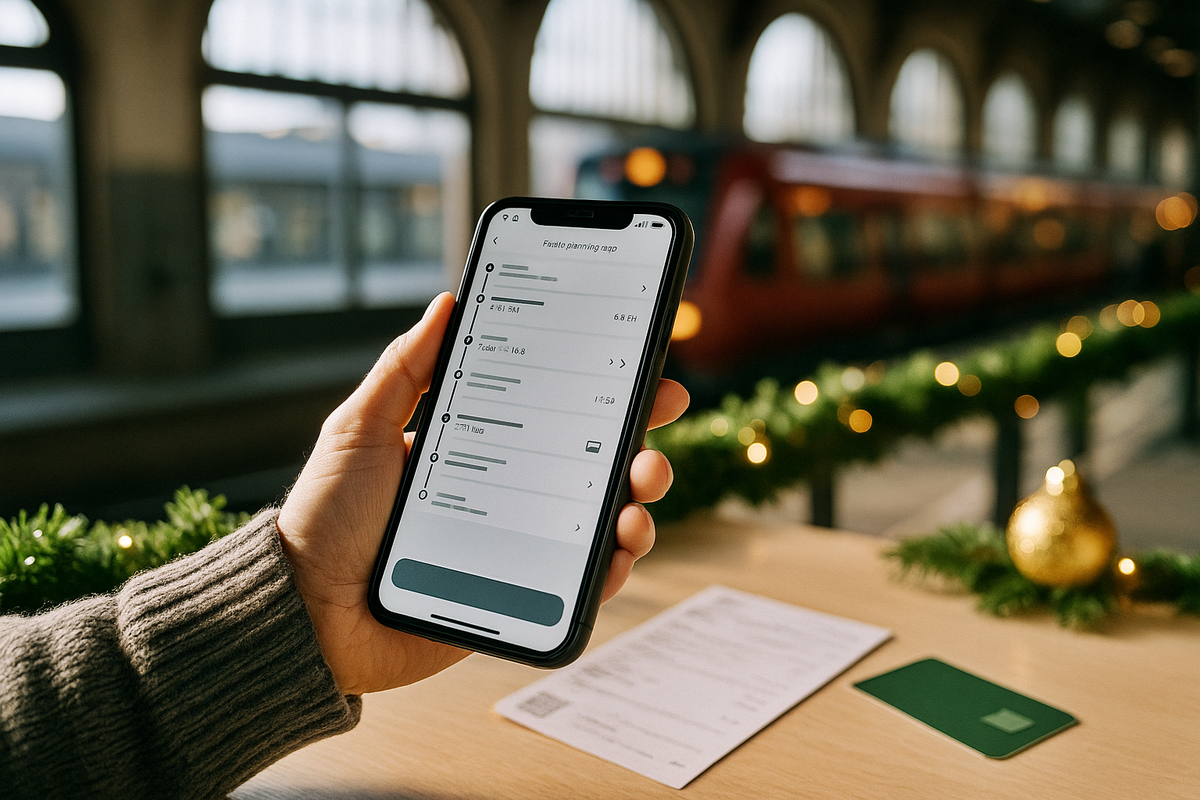🚉 Transport during the holidays: 24–26 December and the night of 31 December to 1 January without surprises
Life doesn't stop during the holiday season in Denmark, but you can't call it a ‘normal day with Christmas trees’ either: the transport system switches to special, shortened or Sunday schedules.

🎄 On 24–26 December and on the night of 31 December–1 January, trains, S-trains, buses and the metro continue to operate, but intervals increase, some routes are reduced, and in some places there are separate night services.
💸 The ‘I'll decide on the spot’ strategy can easily turn into expensive taxis, missed connections, and many hours of waiting at the station with your luggage.
🧠 The purpose of this article is to provide a clear ‘map’ of holiday transport so that you can build in buffers in advance, understand the risks, and have a working plan B if something goes off schedule.
🧭 Basic principles: how transport works in Denmark during the holidays

🛞 Key players:
- DSB — intercity and regional trains throughout the country.
- S-tog — metropolitan electric trains in the Greater Copenhagen area.
- Copenhagen Metro — operates 24/7 all year round, including holidays.
- City and regional buses (Movia, etc.) — within cities and across Zealand.
- Rejseplanen and DOT — a ‘one-stop shop’ for planning routes and viewing current deviations.
📆 General holiday schedule:
- trains and S-tog switch to a Sunday or holiday schedule: less frequent, with possible later morning departures and early ‘last’ trips;
- buses run at reduced intervals, and some ‘thin’ lines may not run in the evening or at specific times;
- the metro remains 24/7, but night intervals are longer than daytime ones, especially during Christmas and New Year's Eve;
- all changes in dates and times are published in advance, but each year has its own schedule, so you cannot rely on the experience of previous years, only on the current data in Rejseplanen or from operators.
🧩 A simple formula: think of a public holiday as a Sunday with additional nuances — fewer trips, longer intervals, more risks at connections, especially in the evening.
🎄 24–26 December: Christmas intervals and ‘dead’ windows

Around Christmas, the Danes' focus shifts from the city to the family, and transport reflects this.
📅 How the picture changes from day to day
| 📆 Date | 🚌 Typical schedule | 🔍 What to check in advance |
|---|---|---|
| 24 December | Often a shortened day; trains and buses gradually switch to a “Sunday” timetable from midday/late afternoon | Last trains and buses to your destination city or suburb; evening gaps with no service on local routes |
| 25 December | Official public holiday, minimal business activity, everything runs like on a “quiet Sunday” | Less frequent services, late start of morning routes, possible absence of minor routes in the evening |
| 26 December | Still a holiday, but the country slowly “wakes up”; transport is closer to a standard Sunday schedule | How trains run in your region, whether there are evening services and at what intervals |
🎅 24 December (Juleaften):
- Shops and services close early, many at lunchtime — everyone goes to be with their families, trains may be much more crowded than usual.
- By evening, trains and S-tog mostly run on a Sunday/holiday schedule, buses run less frequently, and some lines take long breaks.
- Especially in the capital region, there are ‘gaps’ in the timetable for buses: several hours in the evening without service to the ‘thin’ suburbs.
🎁 25 and 26 December:
- official holiday, only key services, tourist activities and some restaurants are open;
- trains and public transport in general run as on weekends, but with increased intervals and possible absence of low-traffic lines in the evening;
- Buses to small towns and villages may run less frequently than usual, and may not run at all in the evening.
⚠️ Practical rule: On the 24th, you can still plan your travel during the day, but in the evening, only according to a clearly verified schedule, and preferably with a margin of one or two trips before the ‘last’ one. Flying to Copenhagen late in the evening on the 24th with a transfer to the last train to the countryside is a high-risk scenario.
🎆 Night of 31 December–1 January and 1 January: how to leave after midnight

On New Year's Eve, the transport system balances between the holiday and the safe return of people to their homes.
🚇 Metro: the main ‘anchor’ of New Year's Eve
- The Copenhagen Metro operates around the clock, including on 31 December–1 January.
- Intervals increase at night, but it is still the most reliable way to get to areas within the metro zone.
- If you plan to celebrate New Year's Eve in the city centre, choosing accommodation close to a metro station greatly reduces the risks and dependence on taxis.
🚆 S-tog and trains
- During the New Year period, S-tog and regional trains run on special or holiday schedules.
- Late and night services are maintained on some routes, but less frequently than on regular Friday nights.
- Specific ‘last’ and “night” departures should be checked in advance on Rejseplanen for the exact date, rather than following the ‘Friday template’.
🚌 Night buses and 1 January
- Some night bus lines are operating, but there may be increased intervals, shortened routes, and combined services.
- Be sure to check not only the availability of the route, but also the time of the last service from the centre to your area.
- On 1 January, transport usually runs according to the Sunday schedule: late start, long intervals, a ‘sleepy’ city until the afternoon.
✅ Minimum checklist before New Year's Eve:
- save screenshots of the ‘last’ and ‘first’ buses on your phone;
- understand which night routes actually pass near your hotel or home;
- have a backup route via the underground in mind, even if you initially plan to take a train or bus.
🔗 Planning connections and tickets: how to avoid queuing for a taxi

On public holidays, the main strategy is to remove ‘points of failure’ from your route: minimal transfers, the last flight of the day, short transfer windows.
🛞 Buffers and connections
- On 24, 25, 26 December and 31 December–1 January, don't plan your transfers ‘by the book’ with a 5–10 minute buffer — allow for at least one ‘extra’ journey in reserve.
- When combining train and plane or train and train, it is advisable to have a buffer of one hour or more to allow for minor delays or crowds at boarding.
- If a trip to a small town requires a bus after the train, first check the bus: does it run in the evening and how reliable is it?
🎫 Tickets and passes
- City and regional passes (City Pass, travel cards) are usually valid on holidays, but it is important to understand which zones and types of transport they cover.
- Some night or intercity trains may require a separate ticket or seat, even if you have a general travel card.
- On popular Christmas days and before New Year's Eve, DSB trains can be very crowded, so it is better to buy tickets in advance rather than at the last minute.
🔍 A realistic approach: it is better to arrive at your transfer point early and wait an extra hour in a warm room than to save 30 minutes on paper and then look for a taxi among dozens of people with suitcases.
🧩 Plan B: taxi, waiting and ‘don't panic’

Even with good planning, there can be delays, cancellations and the last bus ‘running away’ — it is important to understand what to do next.
🚖 Taxis and car sharing as a contingency plan
- On Christmas Eve and New Year's Eve, the demand for taxis increases sharply, and the wait and price may be higher than usual.
- It makes sense to find out in advance where the main taxi ranks are (central station, airport, large squares) and which apps work in your area.
- It is important to treat taxis as a plan B rather than your primary strategy: with good preparation, you reduce the likelihood of having to pay double the fare.
🧳 How to wait out a long layover between flights
- Large hubs (airports, central stations) almost always have warm waiting rooms, cafes, toilets, and luggage storage.
- If there is a long layover in your schedule, it is sometimes better to leave earlier and spend an extra hour in comfortable conditions than to risk missing your connection.
- A practical combination: luggage storage + a nearby café/food court = a controlled buffer, rather than stress on the platform.
📲 Check not only the day before, but also on the day itself
- During the holidays, it is important to check not only the basic timetables, but also operational notifications: delays, reductions, train replacements with buses.
- On the day of travel, it is worth checking the route again in Rejseplanen: changes due to holidays and weather may appear after the fact.
✅ Quick checklist for holiday transport in Denmark

- 🔍 Check the type of timetable for the dates you need: regular, Sunday, holiday.
- 🛞 Allow for a buffer: at least one ‘extra’ trip or hour at key connections.
- 🎫 Check whether your travel cards/passes are valid for night and intercity trips.
- 📆 Avoid arriving in the evening on the 24th and taking the ‘last trains’ to small towns without checking local buses.
- 🚇 Plan in advance how to get to your hotel at night on 31 December–1 January: metro, S-train, night buses.
- 📲 Save screenshots of routes and ‘last departures’ on key dates on your phone.
- 🚖 Keep a backup plan in mind: taxi/waiting at a major hub, rather than spontaneous decisions on an empty platform.
This way, transport during the holidays turns from a lottery into a manageable process: with the right preparation, you save both your budget and your nerves, and Christmas and New Year's Eve in Denmark remain about lights and gatherings, rather than a race for the last train.
❓FAQ
💡 Public transport does not stop, but switches to holiday and ‘Sunday’ schedules with less frequent services and reduced routes, especially in the evenings.
💡 It is better not to plan any critical trips on the evening of 24 December: some routes have long breaks, the last trains and buses leave early, and connections become risky.
💡 The most reliable option is the metro, which runs 24 hours a day, while S-tog and buses need to be checked on Rejseplanen for the specific date to find out the ‘last’ and night-time services.
💡 For Christmas and New Year's Eve, it makes sense to buy tickets in advance because trains are often completely full, and standing in the aisle with your suitcases is a very real scenario.
💡 During the holidays, it is wise to allow for at least one ‘extra’ train or about an hour's buffer at key connections and, instead of calculating ‘just in time’, plan to wait in a warm room rather than on the platform.





0 comments
Log in to leave a comment